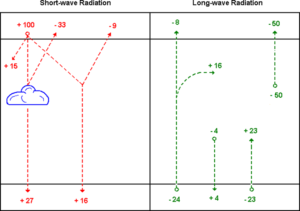Terrestrial Radiation
The absorption of solar radiation raises the temperature of the earth’s surface and atmosphere. The radiation emitted from the land and water surfaces of the earth is long-wave radiation, unlike the short-wave radiation it receives from the sun. The earth’s average temperature approaches 294 Kº, and it emits long-wave radiation within the range of 4μ-80μ, with a maximum at 10μ. Water vapour in the atmosphere is a strong absorber of long waves, particularly between 5.5μ and 7μ and above 27μ.
Albedo
Albedo is defined as the ratio of reflected radiation to the total intercepted radiation. It is often described as a percentage of reflected radiation. The albedo of the earth-atmosphere system is 0.30, meaning that 30% of the total intercepted solar radiation is reflected. In contrast, the moon has an albedo of about 0.07, indicating that it absorbs most of the solar radiation striking its surface.
As a result, when viewed from space, the earth appears brighter than the moon. This is primarily due to the presence of clouds, which reflect more sunlight. The moon, lacking an atmosphere and clouds, reflects significantly less light.
Typical Albedo Values
- Fresh snow: 0.75 – 0.90
- Cloud tops: 0.60 – 0.90
- Old snow: 0.50 – 0.70
- Sand: 0.15 – 0.35
- Seas (high sun angle): 0.05 – 0.10
- Forests: 0.03 – 0.10
Terrestrial Heat Balance
The mean temperature of the earth undergoes fluctuations over varying periods. Averaging these fluctuations over several years can smooth out rapid changes. The remaining slower variations provide evidence of a net gain or loss of energy during the period of averaging. However, these changes are so gradual that the net energy change per year is very small.
Generally, there is no significant long-term trend in the earth’s mean temperature during interglacial periods. A long-term mean heat balance exists at each point of the earth and its atmosphere.
Solar Radiation Distribution
The total amount of solar radiation received on a horizontal surface is about 0.5 ly min-1. This estimate represents the northern hemisphere, but the difference with the southern hemisphere is presumed to be small. Of this, 27% penetrates directly to the earth’s surface, and 16% arrives as diffuse sky radiation, meaning that 43% reaches the ground together.
The atmosphere, including clouds, absorbs 15% of the incoming radiation. The remaining 42% is reflected back into space, which represents the albedo of the earth-atmosphere system. This reflection is composed of 33% from clouds and the ground and 9% from diffuse reflection.
Heat Balance of Incoming and Outgoing Radiation
It is observed that 16% of the diffuse radiation reaches the ground, which is higher than the 9% returned to space. This is because larger dust particles scatter more radiation away from the sun than towards it.
In total, 42% of the incoming solar radiation is directly reflected back into space, while the remaining 58% is absorbed by the ground and atmosphere. Since the yearly mean temperature of the earth remains relatively constant, this 58% must be radiated back to space. The upward radiation from the ground is known as the effective radiation.
Radiative Exchanges Between the Earth and Atmosphere
The difference between the actual radiation emitted by the ground and that from the atmosphere towards the ground is 24%. Of this, 16% is reabsorbed in the atmosphere, while 8% is returned directly to space. An additional 50% of the absorbed radiation is radiated back to space by the atmosphere.
Heat Transport by Turbulence and Condensation
When considering heat transport by turbulence and condensation, the earth’s surface and atmosphere each maintain a heat balance. This transport of heat is estimated at 4% and 23%, respectively.
Terrestrial Heat Balance
Receives
| By Direct Radiation | 27% |
|---|---|
| By Diffuse Radiation | 16% |
| By Turbulent Transfer | 4% |
| Total | 47% |
Loses
| By Radiation | 24% |
|---|---|
| By Condensation (Evaporation) | 23% |
| Total | 47% |
The Atmosphere
Receives
| By Absorption of Solar Radiation | 15% |
|---|---|
| By Absorption of Ground Radiation | 16% |
| By Condensation | 23% |
| Total | 54% |
Loses
| By Radiation | 50% |
|---|---|
| By Turbulent Transfer | 4% |
| Total | 54% |


